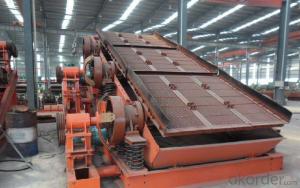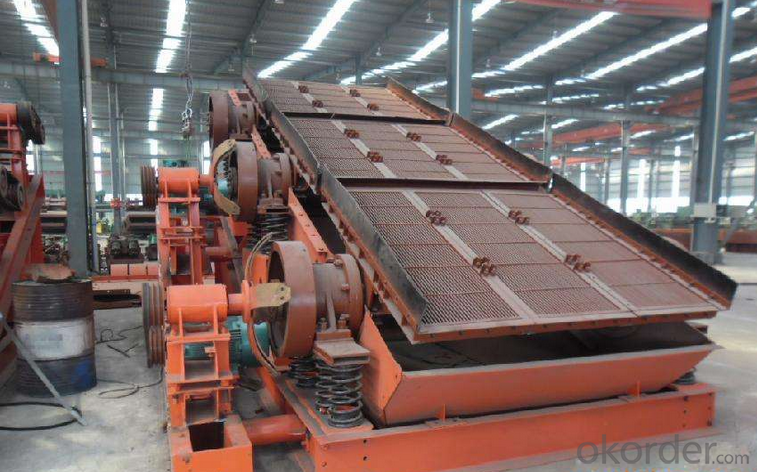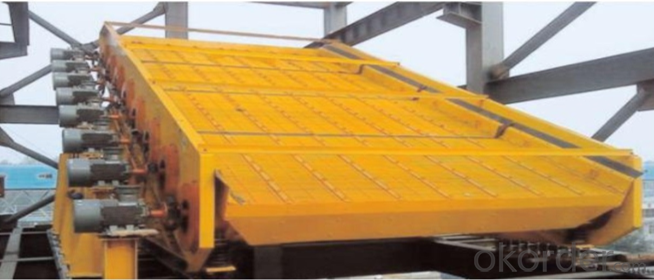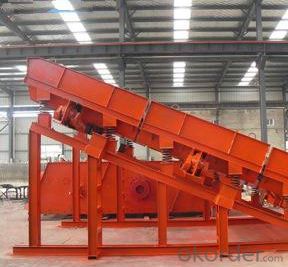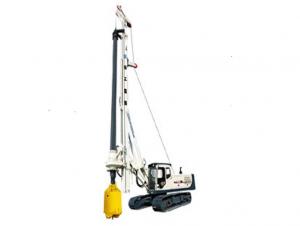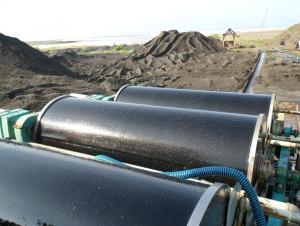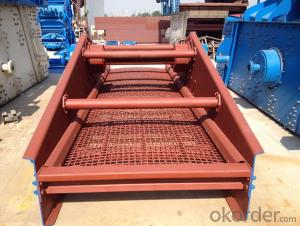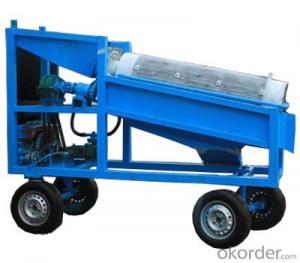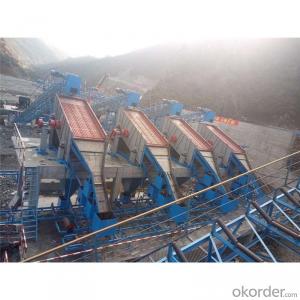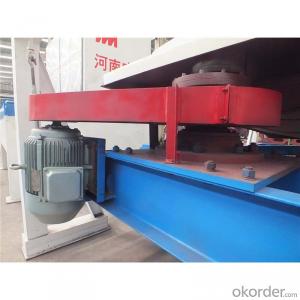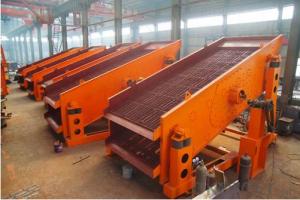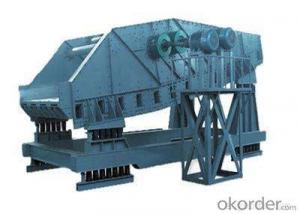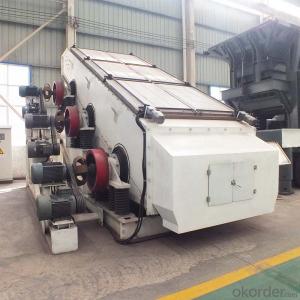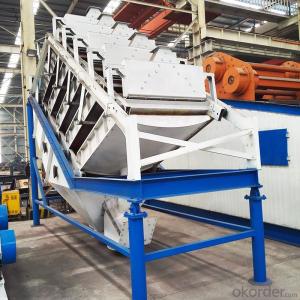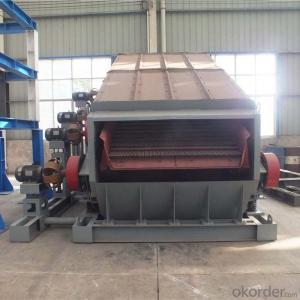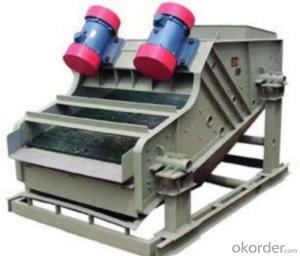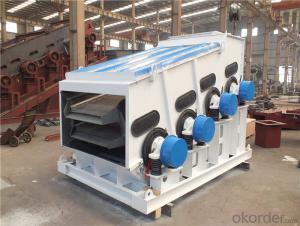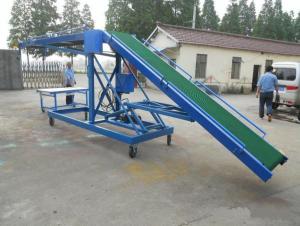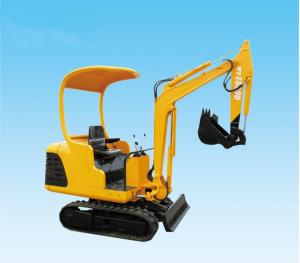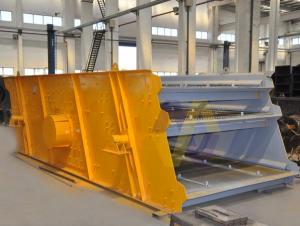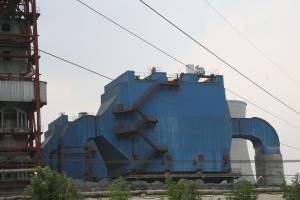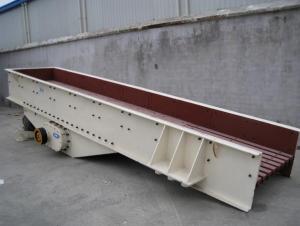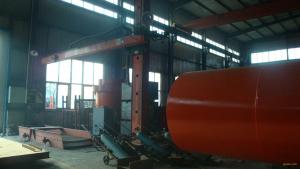GFS High-Amplitude Vibrating Screen,Mining Equipemnt,High-Frequency
- Loading Port:
- China main port
- Payment Terms:
- TT OR LC
- Min Order Qty:
- 1 set
- Supply Capability:
- 100 set/month
OKorder Service Pledge
OKorder Financial Service
You Might Also Like
Profile
GFS high-amplitude vibrating screen is a kind of heavy-intensity circular vibrating screen which is produced by our company, what’s more, which has been widely applied to classifying the materials which have different particle sizes. The whole equipment is composed of multiple segments, therein, every segments is the independent vibrating units, as a result, the equipment has small vibration quality and unlimited moisture in the feeding materials, what’s more, due to the non-blocking screening, strong screening capacity and large processing quantity, the equipment is especially suitable for the deep screening of 6mm(above)wet materials.
Structure features
It is convenient to be installed with small repairing quantity and low operation costs.
There is no screen clogging phenomenon with high screening efficiency.
It has high vibrating amplitude, low frequency and small failure load.
The material flow can be adjusted according to the actual demands, therefore, it can be operated reliably.
It has simple structure, attractive appearance and favorable dust-proofing effect.
The protective devices are installed on the terminal of vibration exciter and the connection parts, therefore, it can be operated safely.
The screening performance is affected significantly by various factors such as equipment capacity and angle of inclination, in which the performance can be measured by screening efficiency and flux of the product.
Flux is defined as the amount of a desired component (undersize material) that has carried over the screening media from the feed per time per unit area. Screening efficiency is expressed as the ratio of the amount of material that actually passes through the aperture, divided by the amount in the feed that theoretically should pass. Commercially perfect screening is considered to be 95% efficient if the process is operated with appropriate feed concentration and size particles. Generally, a suitable particle size difference between sieving and feed should be no more than 30%. High screening efficiency can reduce the qualified gain content in cyclic loading and screening and thus increasing the processing capacity of the mill.
The equipment capacity is almost directly proportional to screen width. This means that by increasing the length, there will be additional chances for passage, and will usually lead to increase in transmission and efficiency. In general, the standard size of screen length should be two to three times the width.However, certain special situations such as restricted space may require a different design.
Angle of inclination can be designed based on the desired mineral grain. For example, wet sieving angle is generally around 25 ± 2 ° for concentrator. Increasing the slope of a screen will effectively reduce the aperture by the cosine of the angle of inclination. At the same time, the materials also move across the screen faster which leads to more rapid stratification. However, the performance tends to decrease after a certain point since the slope of the deck is too high and most particles will remain on the oversized stream instead of passing through the aperture, thus, lower flux is yielded.
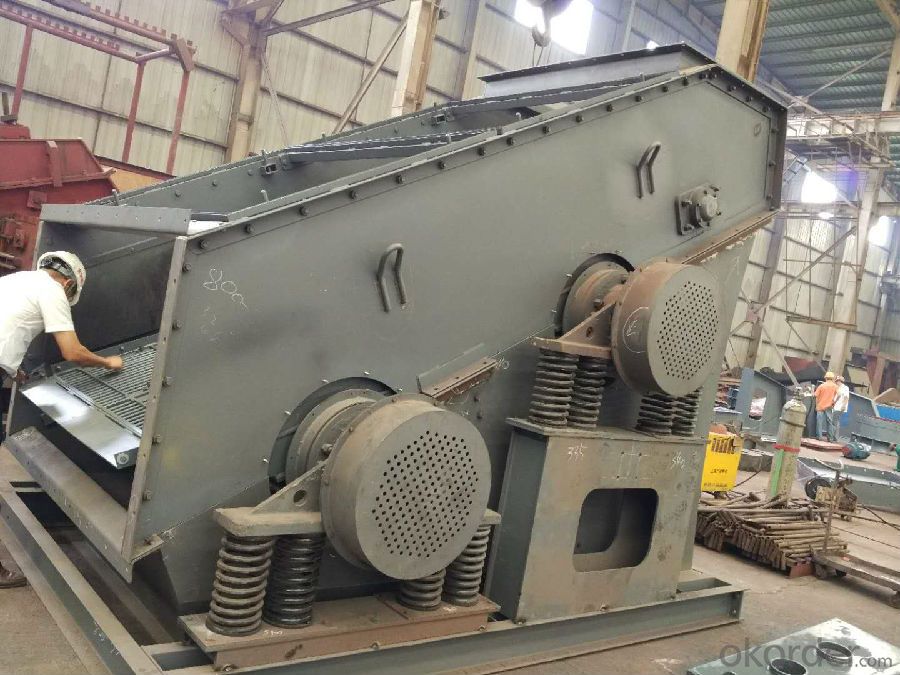
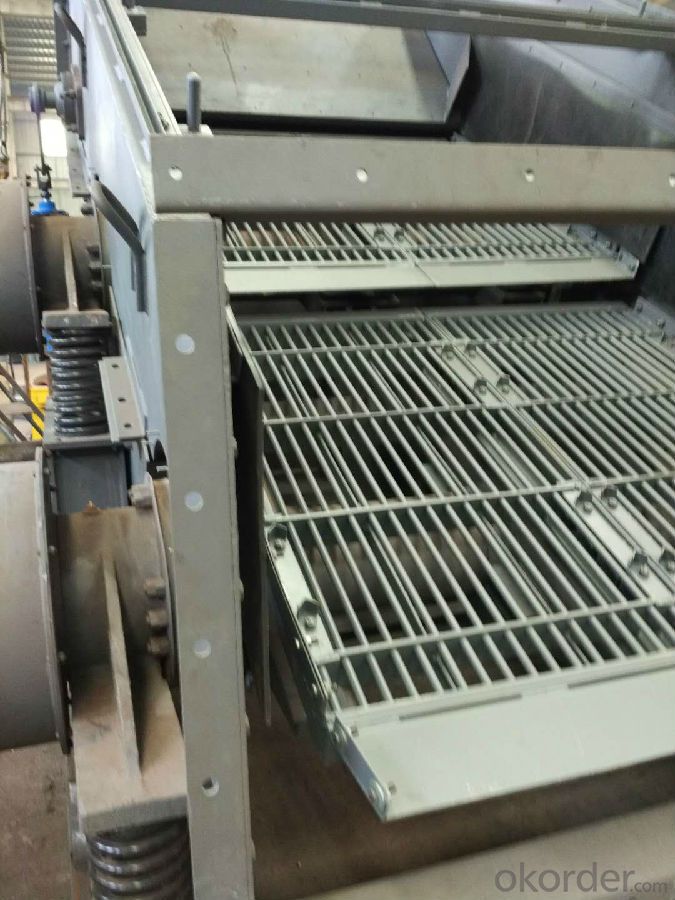
.
Technical specification
Model | Screen specification | Leaning angle of screen(°) | Screen Size (mm) | Vibrational frequency (Hz) | Amplitude (mm) | Size of input granularity (mm) | Handling capacity (t/h) | Motor power (KW) |
GBS-1530/2 | 1.5*3.0 |
20~27 |
5~50 |
12.2 |
5~12.5 |
≤300 |
90~255 | 7.5×2 |
GBS-1545/3 | 1.5*4.5 | 7.5×3 | ||||||
GBS-1845/2 | 1.8*4.5 | 150~450 | 11.0×2 | |||||
GBS-2060/3 | 2.0*5.7 | 200~550 | 11.0×3 | |||||
GBS-2565/4 | 2.5*6.5 |
300~650 | 11.0×4 | |||||
GBS-2582/5 | 2.5*8.2 | 11.0×5 | ||||||
GBS-25100/6 | 2.5*10.0 |
11.0×6 | ||||||
GBS-30120/6 | 3.0*12.0 | 350~680 | ||||||
GBS-35100/6 | 3.5*10.0 | 420~750 | 22.0×6 | |||||
GBS-40100/6 | 4.0*10.0 | 450~850 | 30.0×6 | |||||
GBS-50125/8 | 5.0*12.5 | 550~950 | 37.0×8 | |||||
Notes: The processing capacity is the reference value which is calculated according to | ||||||||
The foregoing attached table shall only be used for reference. The actual application shall be appropriately modified according to customers requirements.
Working principle 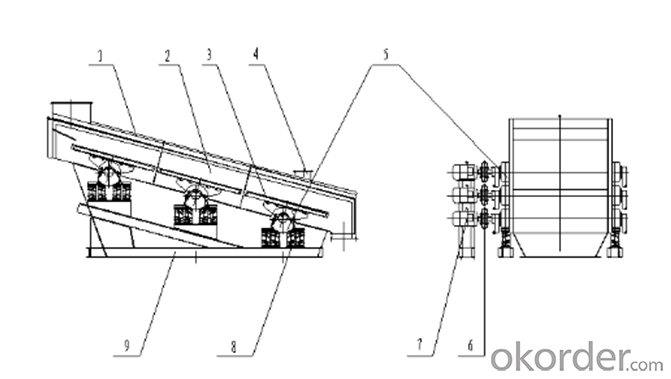
1. Sealed cowling
2. Straining box
3. Sieve tray
4. Dust extraction
5. Exciter
6. Flexible connection device
7. Motor
8. Damping spring
9. Cork bottom
Structure of exciter
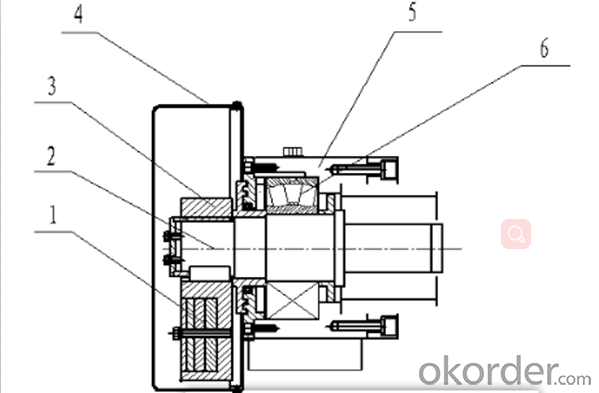
1. Balancing weight
2. Axis of rotation
3. Eccentric block
4. Protective cover
5. Bearing house
6. Bearing
1. Voltage meter 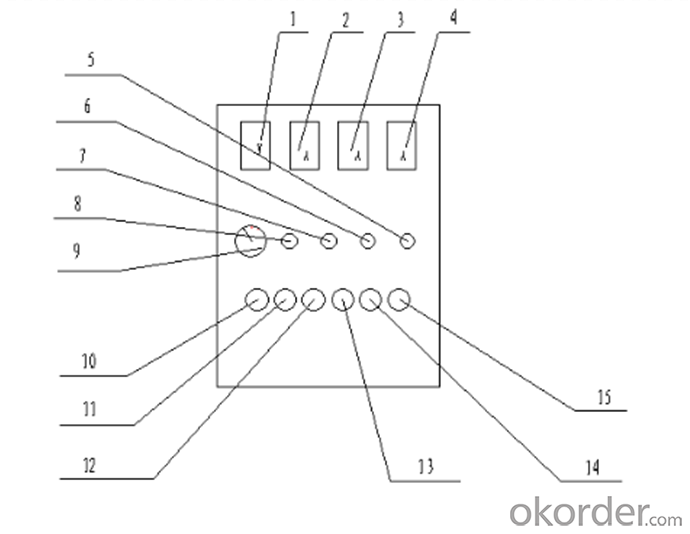
2. Ampere meter(1)
3. Ampere meter(2)
4. Ampere meter(3)
5. Fault indicating lamp
6. Indicator(1)
7. Indicator(2)
8.Indicator (3)
9.Alternative switch
10. Starting(1)
11. Stop(1)
12. Starting(2)
13. Stop(2)
14. Starting(3)
15. Stop(3)
New development
Screen improvements
The research on high-amplitude vibrating screens has led to new developments in the field which enhance the operation and performance of the equipment. These new developments include the stacking of up to 5 individual screen decks placed on top of the other and operating in parallel. A divider system splits the feed slurry to each stack sizer screen, then to each screen deck on the machine. Each screen deck has an undersize and oversize collection pan which will respectively go into their common outlet. The stacking of the machines thus allows more production while using less space. Another new development is the fabrication of Polyweb urethane screen surfaces that have openings as fine as 45 µm and open areas from 35% - 45%. This leads to the screen being able to separate finer particles. The screens can be used for both wet and dry applications and urethane formulation is still an ongoing process. Thus, research and development is still being invested in high frequency screening equipment to improve the overall separation efficiency and also to lower costs.
Mechanical part modifications
To further optimize the performance for high-amplitude vibrating equipment, a "variable speed" hydraulic vibrator is being developed and used to drive the screen decks. It utilizes fluid hydraulic force which then can be converted into rotary power in order to generate high frequency vibration. This modification allows equipment to operate at higher frequency range, up to 8200 RPM, compared to the conventional electric vibrators. Besides that, the induced vibration also creates an excellent condition for separating finer particles and improves the contacting probability for the materials. Another variation that could be applied to the equipment is the "rotary tensioning system’, in which it helps to provide a quicker screen media change. Therefore, multiple applications can be achieved by single equipment, as with different size of feed material can be deal by replacing screens in a very small downtime. Hence, it improves the economic benefits of plants.
FAQ
What’s the difference among the high-amplitude vibrating screen and other vibrating screens?
Comparing with other vibrating screens, the high-amplitude vibrating screen has a essential difference in the structure of vibrating screen. In terms of the common vibrating screen, the whole straining box drives the sieve tray vibrating. On the contrary, the high-amplitude vibrating screen not only has sieve tray vibrating and the box straining is not involved in vibrating, but also the high-amplitude vibrating screen has so many vibrating units.
Where do the high-amplitude vibrating screen be used in ?
The high-amplitude vibrating screen is used to handle the materials which has a large viscosity and high water cost. Because the amplitude of the high-amplitude vibrating screen is high, it has a good efficiency to handling the materials.
What’s the common type of the high-amplitude vibrating screen?
Generally speaking, the sieve tray adopts bars. The sieve tray has the function of self-cleaning, which can reduce phenomenon that the hole in the sieve tray is blocked.
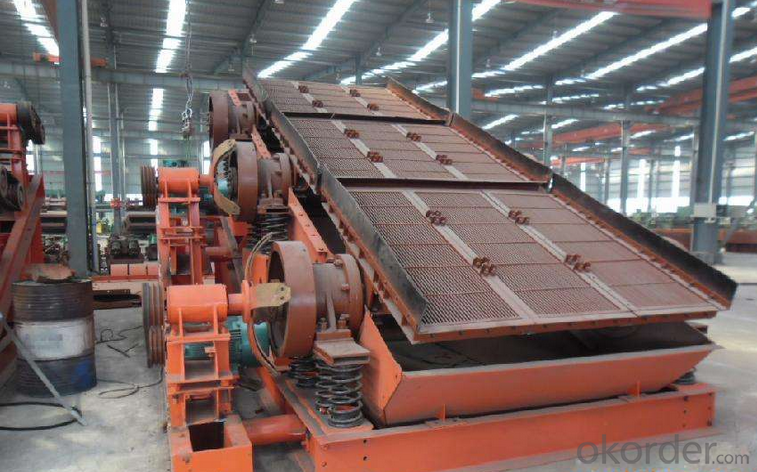
- Q: How should the double-layer vibrating screen be configured with screen mesh?
- Double deck screen should use the 2 screen, like the type 7500 galleons of asphalt mixing station vibration sieve 9 and a half screen of 10 kinds of specifications, production of 10 kinds of mixture, for the construction of high grade highway.
- Q: What is the difference between a circular vibrating screen and a linear vibrating screen?
- Circular vibration sieve and line screen work is not the same, the material on the screen of the line is jumping up and down and move forward, the trajectory of circular vibration sieve is an ellipse trajectory, two dice are not the same, and the shape is not the same.
- Q: How does the mine vibration sieve do not do?
- Extended length and width increases the vibration sieve screen surface area or improve the vibration power to improve vibration amplitude. The so-called sieve is not clear, mainly because the slag in the vibration screen surface time is short, the coal is not separated from the gangue, but also with the gangue rolling.
- Q: Soy milk filter is a good vibrating screen or a centrifuge?
- Each has its own features, centrifugal recommendation
- Q: How to see the number of mesh vibration sieve
- This you do not need to calculate, if you want to buy it only needs the material characteristics and you want what kind of screening effect tell manufacturers they will do, of course, you can also go to the count, the number is 1 inches in screen, you can count.
- Q: What is a vibrating screen for mining? What kinds do you have?
- Mining vibrating screen is what we often say that the heavy sieve screening is mainly suitable for large particles, the common models are: YK series of eccentric vibration sieve, sieve dehydration, high efficiency heavy vibration sieve, sieve, the probability of hot screen cold screen, etc.. Mainly for the industry has mines, coal mines, metallurgy, power and other industries.
- Q: General ultrasonic vibration sieve for the purpose of how many nets, 100 of the target material does not add ultrasonic influence?
- The ultrasonic vibration sieve mainly aims at the screening of ultra fine powder materials and some materials with adsorption, sticky net, electrostatic and light weight
- Q: What kind of material is the vibrating screen generally?
- Generally 316L, according to screening materials selection screen
- Q: Is there one or two motors in the linear shaker?
- But the single vibration motor is not so good in sieving, output and precision.
- Q: What is the screen frame of a linear vibrating screen?
- The screen frame of the linear vibrating screen can not be exactly what kind of good. It can only be said that each material has the advantage of each kind of material
Send your message to us
GFS High-Amplitude Vibrating Screen,Mining Equipemnt,High-Frequency
- Loading Port:
- China main port
- Payment Terms:
- TT OR LC
- Min Order Qty:
- 1 set
- Supply Capability:
- 100 set/month
OKorder Service Pledge
OKorder Financial Service
Similar products
Hot products
Hot Searches
Related keywords
